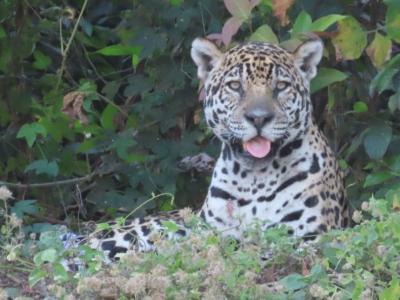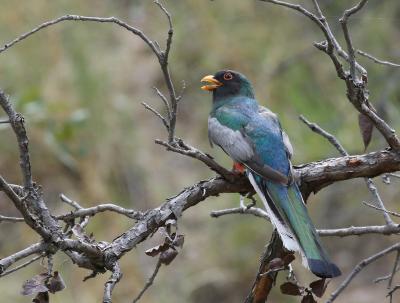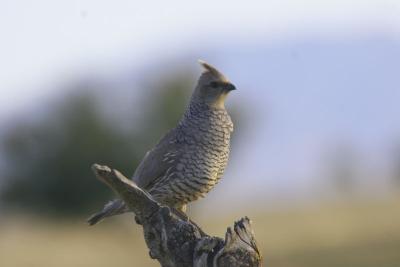New Mexico in Winter
Santa Fe to the Bosque
-
Jan - Feb, 2027
Tour Price to be Determined
Tour Price to be Determined
As we explore the central corridor of New Mexico, we’ll travel through riverine cottonwood stands along the Upper Rio Grande River, expansive fields and ponds where countless waterfowl and cranes spend the winter, large lakes attractive to wintering waterbirds, and snowcapped mountains swathed in conifer forest. Along the way we’ll witness one of North America’s greatest wildlife spectacles, as tens of thousands of geese, ducks, and cranes fill the air at Bosque del Apache NWR. We’ll also be able to study New Mexico’s many wintering sparrows and raptors, and hope to encounter all three species of North American rosy-finches.
Day 1: The tour begins at 6:00 pm in the lobby of our Albuquerque, New Mexico hotel.
Day 2: We’ll visit a nearby canyon where hillsides are covered in pinyon-juniper and montane scrub to search for resident birds such as Gambel’s Quail, Ladder-backed Woodpecker, Western Scrub-Jay, Juniper Titmouse, Bushtit, Cactus Wren, Rock Wren, Western Bluebird, Curve-billed and Crissal Thrashers, and Townsend’s Solitaire. After an early lunch in Albuquerque we’ll check a fabulous local fishing pond that hosts dozens of species of waterfowl in the winter months, if time allows we’ll walk the trails into the adjacent bottomland cottonwood forest along the Rio Grande. In the afternoon we’ll drive south towards Truth or Consequences (T or C), stopping along the way for Sagebrush Sparrow. This drive takes us through the heart of the Chihuahuan Desert where we stand a chance at encountering many wintering raptors, including Golden Eagle, Prairie Falcon, and Ferruginous Hawk. We’ll have dinner in T or C, get checked-in, and then you should have time to shake off the drive in a private hot springs bath at our hotel. Night Truth or Consequences.
Day 3: We’ll have an early breakfast and make our way south to southern New Mexico, near the city of Las Cruces, where the heavily vegetated neighborhoods harbor great wintering birding opportunities; resident species such as Harris’s Hawk, Inca Dove, Cactus Wren, Pyrrhuloxia, Verdin, and Black-tailed Gnatcatcher can be found in the desert scrub while the warmer average winter temps and many bird feeders make it possible for hummingbirds and other exciting vagrants to overwinter. The surrounding grasslands are a refuge for many special grassland species including Chihuahuan Raven, Sprague’s Pipit, Baird’s and Grasshopper sparrows, Lark Bunting, and occasionally Short-eared Owl. We’ll try our chances at locating as many of these species as we can manage to kick out of the grass. After a good long day of birding we’ll make our way back to T or C for more good food and hot springs. Night Truth or Consequences.
Day 4: We’ll depart early and drive south to Las Animas Creek, the only drainage east of the continental divide with native Arizona Sycamores. The unique habitat here should produce gaudy Acorn Woodpeckers and perky Bridled Titmouse. Extensive stands of riparian woodlands and stretches of Chihuahuan Desert scrub attract large numbers of wintering landbirds, and we’ll be alert for such species as Gambel’s Quail, White-winged Dove, Greater Roadrunner, Black and Say’s Phoebes, Chihuahuan and Common Ravens, Verdin, Cactus Wren, Red-naped Sapsucker, Pyrrhuloxia, and Phainopepla. If adequate monsoon rains have occurred an impressive diversity of sparrows use the area in winter, including, Black-throated, Brewer’s, Chipping, and Rufous-crowned, as well as Spotted, Canyon, and Green-tailed Towhees. From here we’ll continue south to areas around Caballo Lake and Percha Dam, some of the best birding locations in the state, and one of few places in the state where Vermilion Flycatchers often overwinter. On almost every visit to these areas something unexpected turns up, and birding here is always exciting. After lunch we’ll look over Elephant Butte Lake, rich in waterbirds and perhaps the best place in New Mexico for wintering gulls. On previous visits we have turned up rarities such as Glaucous and Lesser Black-backed Gulls among the flocks of Ring-billed Gulls. From here we’ll drive north to our accommodations near Bosque del Apache NWR. Night in Socorro.
Day 5: If we have the good weather that is typical here, we’ll be in for a real treat this morning at Bosque del Apache. A slight chill will permeate the crisp, still-dark morning air as we stand along the road at the refuge. Just as the first hint of dawn encroaches from the east it begins: a few isolated bugles and honks at the start and then a rising swell of sound. As dawn takes hold, literally thousands of Snow and Ross’s Geese begin to leave their nighttime roosts, filling the air with their bodies and our ears with a veritable symphony. Listening to this cacophony and watching the flocks whirl overhead in the early morning light is an awesome experience. After the morning fly-out, we’ll spend the rest of the day exploring the two loop roads around the refuge, the refuge headquarters, and a trail into desert scrub just south of the refuge for a host of grebes, ducks and geese. The north end of the refuge is productive for Wild Turkey, Greater Roadrunner, and raptors such as Ferruginous Hawk, Merlin, and Bald Eagle. Mixed species flocks of blackbirds congregate in the tens of thousands and often include Brewer’s, Yellow-headed and Red-winged Blackbirds. More often than not there are many wintering shorebirds around on the refuge and we’ll spend some time picking through them for anything unusual. We’ll enjoy a picnic lunch at the refuge headquarters. In the afternoon we’ll visit a native grassland just east of Bosque and look for wintering raptors, several species of grassland sparrows and longspurs, and the recently recognized Chihuahuan Meadowlark. As twilight approaches, we’ll visit a different roosting pond to watch the evening return of the Sandhill Cranes. Night in Socorro.
Day 6: This morning we’ll drive to Santa Fe by way of a scenic highway that passes through juniper-clad slopes, expansive grasslands, and deep canyons where we may encounter birds such as Pinyon Jay, Townsend’s Solitaire, Mountain Bluebird, Sage Thrasher, Horned Lark. The grasslands along this route are often great places to find Golden Eagles. We’ll keep an eye out for the American Pronghorn along this route as well. After lunch we’ll have our first chance at seeing the wintering Rosy-Finches of Sandia Crest. After some feeder watching we’ll head back downslope and north for the last leg of our trip to northern New Mexico. Night in Santa Fe.
Day 7: We’ll spend the morning exploring the road up to the majestic Santa Fe Ski Valley, where we’ll hope to encounter Clark’s Nutcracker, Gray Jay, Pine Grosbeak, and possibly the ever-elusive Dusky Grouse. Once done in the mountains we will, weather permitting, drive north to the expansive short grass prairie at the Las Vegas National Wildlife Refuge or farther to Maxwell NWR. Here we hope to encounter more northerly species such as Rough-legged Hawk, Tundra Swan, Black-billed Magpie, and American Tree Sparrow. Depending upon conditions we may elect to drive north to Taos and Angelfire, along the scenic Rio Grande gorge, where wintering American Dipper and Barrow’s Goldeneye are possible. Night in Santa Fe.
Day 8: Our final full day will find us exploring Sandia Crest with hopes of studying three species of rosy-finch. The Sandias are one of a handful of locations in the U.S. where all three “rosies” occur at the same time, offering an unusual chance to learn how to separate these sometimes-similar species. This site has been the host of a long-term banding study of New Mexico’s wintering rosy-finch population, spearheaded by your guide back when he was 12. With luck we’ll have the chance to view these birds, though their yearly occurrence has become much less predictable due to recent changes in winter weather patterns. The road that winds up to the crest offers good montane birding, and we’ll search for species such as Northern Pygmy-Owl, Steller’s Jay, Red-breasted and Pygmy Nuthatches, and possibly American Three-toed Woodpecker and Williamson’s Sapsucker. Finches are generally plentiful in the coniferous forest here, and most years we encounter flocks of Pine Siskins and Red Crossbills as well as the occasional Cassin’s Finch. Night in Albuquerque.
Day 9: The tour concludes this morning in Albuquerque.
Note: The information presented below has been extracted from our formal General Information for this tour. It covers topics we feel potential registrants may wish to consider before booking space. The complete General Information for this tour will be sent to all tour registrants and of course supplemental information, if needed, is available from the WINGS office.
ENTERING THE UNITED STATES: Non-U.S. citizens will need a valid passport and may need a tourist visa. Consult your nearest U.S. Embassy or consulate for details. Canadian citizens should carry proof of citizenship in the form of a passport or birth certificate.
Please note that non-US citizens are required by law to carry passports/visas with them at all times. We suggest you carry these documents with you in your day pack or some place that is easily accessible (not locked in your luggage). Because of proximity to the US-Mexico border, US Border Patrol checkpoints are possible on the roads and foreign nationals may be required to produce passports.
HEALTH: New Mexico presents no real hazards to the visiting birdwatcher but certain factors must be considered. In winter, storms and occasionally intense cold can occur. Morning temperatures are often in the teens so suitable winter clothing, especially a warm hat, parka, a sturdy pair of gloves and good footwear are essential. The key to remaining comfortable is to bring many layers of clothing, and to adjust through the day as needed. On our days in the mountains we will likely encounter snow, so waterproof hiking boots with good tread will come in very handy. Insects will not be a problem at this time of year.
As it may be difficult to replenish supplies of personal medications, please anticipate your needs and bring an adequate supply.
SMOKING: Smoking is prohibited in the vehicles or when the group is gathered for meals, checklists, etc. If you are sharing a room with a non-smoker, please do not smoke in the room. If you smoke in the field, we ask that you do so well away and downwind from the group.
If any lodge, accommodation or location where the group is staying or is gathered has a more restrictive smoking policy than WINGS’ policy, the more restrictive policy will prevail.
PACE OF THE TOUR: This is a relatively relaxed tour, in part due to the short winter day, but full, with departures usually around 7 AM and returns to the hotel usually by 5 PM. Although we spend some time on foot, our walks are at a leisurely pace and on flat terrain. We will encounter a wide range of altitudes on this trip, as the Sandia Crest House is 10,678 ft. above sea level. Any activities undertaken by the group at higher altitudes will be paced in accordance with the rarified air. The majority of the walking we will be doing will be flat terrain but it could be a bit icy or walking on packed snow at times. There will be an optional .5 mile walk while at the crest for American Three-toed Woodpecker which will go slightly downhill and is often on packed snow. Folks that do not want to brave this section of trail are more than welcome to enjoy the warmth of the crest house and the rosy-finches. Sturdy shoes and walking sticks are advised. Our birding pace will be leisurely as well and we will have plenty of time to study the birds we see.
BATHROOM BREAKS: We are able to make frequent bathroom stops throughout this tour. We are rarely ever far from a rest stop, gas station, or Forest Service bathroom. There may be times when a break in nature is required, but this is not the norm on this tour.
CLIMATE: January temperatures can vary from the 20s F (occasionally the upper 10s or even lower on the mountains) to the upper 40s or even mid to upper 50s during the day. Wind, snow, and rain are possible anywhere.
ACCOMMODATIONS: We stay at standard motels throughout. A list of hotel addresses and telephone numbers will be sent to participants as part of the final information.
FOOD: Our breakfasts will be taken in the hotels, using their various continental options (including waffles and in some cases eggs and bacon). Lunches and dinners will be taken at standard restaurants, although some of the lunches might be eaten in the field if the weather is conducive. Dinners will be varied, ranging from simpler country fare to upscale dining in Santa Fe, with emphasis placed on the specialties of the region (New Mexican Cuisine, steak).WINGS tours are all-inclusive, and refunds cannot be issued for any meals participants choose to skip. While our restaurants and ground agents make every effort to insure the comfort of all participants, we cannot guarantee that all food allergies can be accommodated at every destination. Thus, participants with significant food allergies or special dietary needs should bring appropriate foods with them for those times when their needs cannot, regretfully, be accommodated. Our tours are carefully scheduled to insure the best possible birding experience. Meal times can generally not be adjusted; any participant who needs to eat earlier or later than the times scheduled for the group should bring supplemental food with them. The leader will provide an assortment of snacks and water in the van. Please contact the WINGS office if you have any questions.
TRANSPORTATION:We will be traveling by 12-15 passenger window van or minivan, depending on the group size. When using 15-passenger window vans, we take a maximum of seven passengers plus the leader. Participants should be able to ride in any seat in tour vehicles and are expected to change seats with others daily.
PHOTOGRAPHY: This is a very easy trip for photographers to join, especially if digiscoping with a spotting scope. The open nature of the habitats in New Mexico make it so that birders and bird photographers can easily coexist. Scenery and memory shots will be plentiful and simple to obtain but birds are difficult to photograph. Although there will be plenty of occasions when bird photography is possible, especially around the Bosque del Apache NWR, a birdwatching tour is not normally the best means of pursuing this aim. “Digiscoping,” on the other hand, is perfectly compatible with the tour, though it is recommended you bring your own telescope! Camera equipment should be packed in moisture- and dust-proof bags, as a precaution.
2024 Narrative
In Summary:
It’s hard to express the stark and ancient beauty of New Mexico’s myriad landscapes in words or photos — you really just need to come witness it for yourself. The land draws you in while its abundant wildlife makes long lasting impressions on your heart. Massive mountains swathed in coniferous forest, and blanketed in snow, rise from the desert like titans. Expansive tracts of riparian woodland line the banks of the Rio Grande for hundreds of miles, providing rich corridors for wildlife movements. The sun unfolds across the morning landscape with unmatched grandeur, and falls away slowly through dreamy tones of gold, red, and purple. We traversed some of the best areas New Mexico has to offer, following the Rio Grande across most of the state, encountering 146 species of birds as a group, a new record!
In Detail:
Day 1: Albuquerque to Truth or Consequences: We began our journey at sunrise in Albuquerque, traveling to the cottonwood gallery forest along the Rio Grande. As we arrived at our first stop, Tingley Bosque Ponds, hundreds of Red-winged Blackbirds were streaming out of the reed beds. A bit of sifting through them produced two male Yellow-headed Blackbirds. The ponds were teeming with waterfowl, including magnificent views of Wood Ducks and Canvasbacks. The local Neotropic Cormorants were beginning to construct their nests on the islands in the fishing ponds. At Embudito Canyon we battled high winds, and though most species were hiding we did enjoy our first views of Ladder-backed Woodpecker and Western Bluebirds. A Crissal Thrasher sang to us from the ground upslope but we saw nothing more than a flick of the tail as it disappeared over a four-winged saltbush and upslope. Exhausted by birding in the high winds we opted for an early lunch at the Guava Tree Cafe in Albuquerque, a delicious Latin American restaurant with a New Mexican spin. It was a favorite meal of many for the trip. Post-lunch we headed southward following the Rio Grande through stunning Chihuahuan Desert grasslands, bluffs and canyons. Just north of Sevilleta NWR we enjoyed our first of many Ferruginous Hawks for the trip, along with a soaring Golden Eagle. In the distance a flock of Chihuahuan Ravens picked at a dead cow. By the afternoon we arrived at Paseo del Rio SP, a desert canyon along the Rio Grande, just downstream from the Elephant Butte Lake dam. For much of the winter a Nutting’s Flycatcher had been haunting the riparian vegetation in this area and while it had become difficult to locate recently we were determined to give it a shot. Wandering along the river we encountered twenty species of birds, including Say’s Phoebe, Brewer’s Sparrow, Spotted Towhee, and Belted Kingfisher. One of the most unique sightings was a covey of Gambel’s Quail eating mistletoe fruits high in the treetops! A Merlin blasted overhead but that didn’t prevent us from locating the Nutting’s Flycatcher - a lifer for many and New Mexico bird 506 for Raymond! It’s always exciting when the guide gets a new record.
From the dam we watched a plethora of American White Pelicans circling up from the lake, across the the namesake Elephant Butte bluff, and into the sunset. After a little New Mexican food we checked-in to the Sierra Grande and enjoyed soaking in the hot springs under the stars.
Day 2: Organ Mountains National Monument and Las Cruces: We started the day like any proper New Mexican birding day should, with breakfast burritos in the town of Hatch, famous as the green chile capital of the World. We took our burritos on the road and headed south toward the city of Las Cruces, New Mexico’s second largest city. Here in the warm southern tier of the state many species overwinter that are completely absent even 80 miles to the north. Our first stop was at Sagecrest Park, a city park with lots of native vegetation and birds. Within moments of stepping out of the van we were watching Phainopeplas calling from the mesquites. This snazzy little silky-flycatcher was dubbed the trip mascot and we enjoyed many more sightings over the next couple of days. Verdins were common in the surrounding desert vegetation while a pair of Cooper’s Hawks carved beautiful courtship circles out of the sky overhead. We watched the hawks’ movements with delight, while a bold Anna’s Hummingbird tried to chase the hawks out of the neighborhood. From here we headed to Dripping Springs in the Organ Mountains National Monument, a fabulous desert mountain protected as a National Monument during the end of the Obama administration. Thousand foot cliffs tower over the Chihuahuan Desert, Madrean woodland, and the remains of a late 19th century mountain resort for residents of the Las Cruces upper class. By the early 20th century this site became a sanitarium for the treatment of people battling tuberculosis.
Along the trail to the springs we laid eyes on Green-tailed Towhee, Rock Wren, Rufous-crowned, Black-throated, and Brewer’s sparrows, and Loggerhead Shrike. We stopped for a while and watched a group of Mule Deer eating prickly pear cactus. A number of Red-tailed Hawks watched on from the cliffs overhead. After a wonderful picnic lunch, with an exceptional view, we headed into town to a dove roost that’s been hosting a small group of Ruddy Ground-Doves. Within moments of arriving we found three huddled up alongside a large flock of Inca Doves, after beautiful views of this rarity from Mexico we began the journey back to the north.
We stopped below Caballo Reservoir Dam and watched a gorgeous male Pyrrhuloxia at close range. Nearby a Vermilion Flycatcher was hunting midges in the last sliver of light in the top of a cottonwood; its already spectacular plumage further enhanced by the light of golden hour. We returned to Truth or Consequences for pizza and our final dip in the hot springs water.
Day 3: Las Animas Creek and Elephant Butte Lake: After a delicious breakfast at the Sierra Grande we headed south to Las Animas Creek, a gorgeous riparian canyon in the heart of the Chihuahuan desert. The northernmost Arizona Sycamores in the state spill down into the flats and allow for an interesting mix of species. Acorn Woodpeckers, a Red-naped Sapsucker, dozens of Lesser Goldfinches, and a couple Bridled Titmice joined a Juniper Titmouse, and a host of sparrows. The ivory white sycamores were a beautiful sight against the creosote desert wash beyond. At Percha Dam State Park we enjoyed prolonged views of Spotted Sandpiper and American Pipit. Below the Caballo Lake spillway we enjoyed lunch before heading to Elephant Butte Lake for a bit of water birding. Enroute to Elephant Butte Lake we stopped at a small park in TorC to search for a Varied Thrush that has been there off and on through the winter. We never laid eyes on the thrush but we heard it well and the audio recordings I made are accessible on the eBird trip report (https://ebird.org/tripreport/200430). Water levels at the lake are much higher than they’ve been for many years which meant that shoreline and marshy habitat was mostly nonexistent, even still, we enjoyed side-by-side comparisons of Clark’s and Western Grebes. American White Pelicans were scattered about the lake. We drove north to Socorro for the night as we watched the sun set over the desert.
Day 4: Bosque del Apache NWR: We left the hotel dark and early to watch the Snow and Ross’s geese leave their roost for feeding grounds north of the refuge. There was no mass exodus this morning, but it was still a gorgeous site as they trickled out in small groups in front of the rising sun.
A spin around the south refuge loop produced a couple of rarities: a White-tailed Kite perched high in a leafless cottonwood, and an adult Trumpeter Swan on the boardwalk pond. On the north loop we stopped for a long time to watch flocks of Sandhill Cranes parachuting in before us at close range. A pair of Javelinas sipped water from a drainage canal and a very tiny, cooperative Sharp-shinned Hawk hunted the stands of screwbean mesquite on the west side of the refuge. At the refuge headquarters we enjoyed lunch and wandered through the cactus gardens, enjoying the curation of desert plants, and the wild birds that utilize them. Just north of the headquarters we found a cooperative Sagebrush Sparrow that sat for prolonged scope views. We birded our way northward stopping for some Crissal Thrasher fun before returning to town for a short afternoon break before dinner and owling.
After dinner we made our way through light rain back to the refuge and scoped a wonderful Western Screech Owl that was vocalizing in the forest along the edge of the Rio Grande. We spent some time searching for Barn and Great Horned owls but the rain and wind was proving difficult and we found no other creatures other than a single Striped Skunk. All said and done we saw nearly 80 species for the day, a fabulous list total for a winter day in the high desert, or anywhere in the USA in February really.
Day 5: Estancia Valley to Santa Fe: The next morning we awoke to predictions of snow to the north. As we made our way to the grasslands of the Estancia Valley we stopped to admire an enormous flock of Snow and Ross’s geese taking flight from the nearby Bernardo WMA. In the nearby grasslands we struck out on Scaled Quail but we found a lovely Sage Thrasher sitting fat and happy in a Oneseed Juniper that was dripping with berries.
A bit further along we stopped in the town of Mountainair for a coffee pick-me-up. The grasslands north of Mountainair weren’t in great shape but it didn’t prevent us from finding a river of Horned Larks, easily 20,000 strong. Ferruginous Hawks lined the roadside all along the way to lunch. After lunch at the Greenside Cafe we attempted to reach the Sandia Crest for our first shot at Rosy-Finches. We were able to drive as far as Ellis Trailhead (within a mile of the mountaintop) before the snow became too deep to continue. Rather than hike two miles in the snow, in 20 degrees farenheit weather, we opted to get off the mountain safely and head toward Santa Fe searching along the route for Pinyon Jays (which we did not find… on this day). This tour has extra time built in for more than one chance at rosy-finches, for this very reason. Near the bottom of the mountain we found a flock of over twenty Steller’s Jays. We made our way to Santa Fe for a delicious East African meal, at the award winning Jambo Cafe, and some much needed sleep at the fabulous El Rey Court, a boutique motor inn built during the glory days of Route 66.
Day 6: Southern Rocky Mountains: We rose early, hit a Starbucks and were on our way to Georgia O’Keefe country in northern New Mexico. Bird diversity in far northern New Mexico is low during the winter but the views of the surrounding desertscape easily made up for the lack of birds. Along the Rio Grande in Espanola we counted thirteen Barrow’s Goldeneyes, and only one Common. We spent the rest of the morning searching for Lewis’s Woodpeckers, and mostly finding Black-billed Magpies. Finally when we were just about to throw in the towel we found a single Lewis’s attending a cavity in a cottonwood snag, it perched in beautiful lighting for a great scope view.
Afterwards we made a trip to the Santa Fe ski basin where we found lunch and not too much else. We did enjoy watching a flock of Common Ravens raiding a cooler in the back of someone’s truck. After lunch a few folks saw a flock of Rosy-Finches flying high above the ski basin trees but they were never close enough to identify and they didn’t stay long. From here we headed to Pecos, NM where we enjoyed watching an American Dipper actively hunting along an icy mountain stream. Other new birds for the trip were Townsend’s Solitaire, Red-breasted and Pygmy nuthatches, and Wild Turkey.
Day 7: Rosy-Finches or Bust: After a Starbucks run we pointed our van to the Sandia Mountains for our last shot at the famous Rosy-Finches. Along the route we encountered 40 Pinyon Jays along Hwy 14 south of Madrid, NM.
We arrived at the Sandia Crest to find the treetops coated in ice and a few of Rosies already waiting for us at the feeders.
Shortly after we positioned ourselves for best viewing to the south of the feeders we were enveloped by a cloud of Black, Brown-capped and Gray-crowned Rosy-Finches affording us with great views and side-by-side comparisons of all three species together. Further downslope we walked among the Ponderosa Pines, finding a small flock of Type 2 Red Crossbills (the ones that like big pine cones and sound like Pygmy Nuthatches). In a nearby tree we watched a Tassel-eared Squirrel eating acorns.
After another lunch at Greenside Cafe we headed back to Albuquerque for a view of the Sandias from the west and a very fruitful wild goose chase. With the setting sun we were able to pick out Canada, Cackling, Greater White-fronted, Snow and Ross’s geese all in the same flock. After a lot of scoping we located the long-staying Brant, a local celebrity that has returned to this site for at least three consecutive winters. As the sun set, marking the end of a fabulous tour in the Land of Enchantment, we took a selfie with a plastic Wile E. Coyote that was intended to scare the geese from the grassy fields (it didn’t repel the geese or us). We capped the trip off with a delicious New Mexican meal in the historical Albuquerque Old Town Plaza.
Raymond VanBuskirk, 2024
ebird Trip Report: https://ebird.org/tripreport/200430
Group maximum seven with one leader.




























